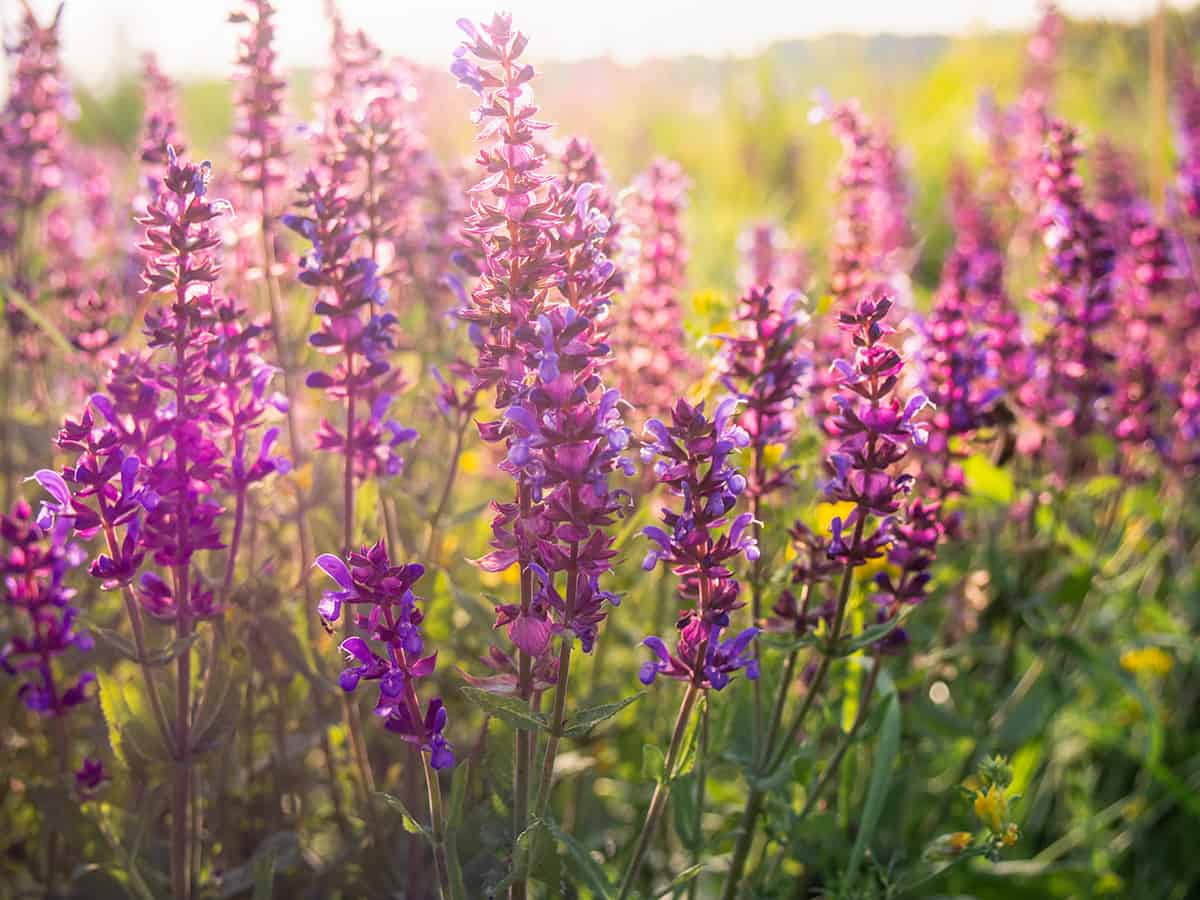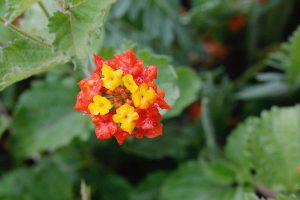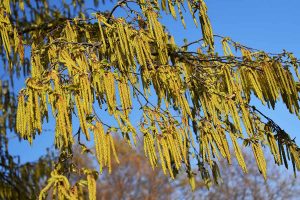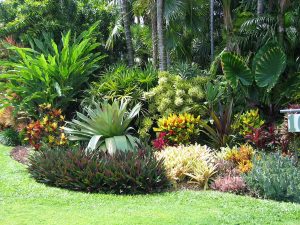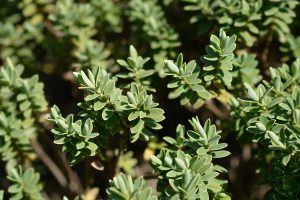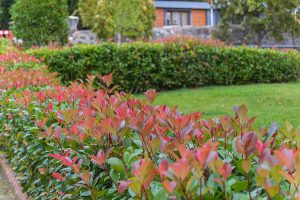Shrubs and bushes with brightly colored foliage can add a lot of interest to the landscape even when flowers are not in bloom. Using plants with purple, red, or orange foliage is a great way to make your garden look lush and vibrant all year round, as opposed to just during the spring and summer months when most plants are at their best.
Here we take a look at a range of shrubs and bushes which produce purple foliage. Some of these are deciduous, while others are evergreen for even longer seasons of interest in the garden.
Table of Contents
Chinese Winter Hazel ‘Spring Purple’
- Botanical name: Corylopsis sinensis ‘Spring Purple’
- Family: Hamamelidaceae
- USDA hardiness zones: 6 – 8
- Mature height: 10 to 15 feet
- Mature spread: 10 to 15 feet
This is a deciduous shrub native to China. The ‘Spring Purple’ variety is named after the fact that the foliage of this plant is purple when it first emerges on the branches during spring. Once mature, the foliage develops to a deep shade of blue-green before returning to dark purple in fall before the leaves are shed.
The flowers of this plant are not particularly showy; however, they arrive in pendulous racemes, which drape from naked branches in early spring and can make the shrub look quite spectacular.
Each flower is a buttery cream shade of pale yellow, and these are quite fragrant. Typically each raceme will measure around 2 inches in length. The Chinese Winter Hazel thrives in partial sun or partial shade and is adaptable to a wide range of soil types. It is relatively hardy, but the buds of early flowers are susceptible to damage from late frosts.
Bush Clematis ‘Purpurea’

- Botanical name: Clematis recta ‘Purpurea’
- Family: Ranunculaceae
- USDA hardiness zones: 3- 9
- Mature height: 2 to 6 feet
- Mature spread: 2 to 4 feet
The Bush Clematis, as you might expect from its common name, is not a climbing shrub like most other types of Clematis. Instead, it has a mound-forming habit, creating dense clumps of elegant foliage and fragrant, showy flowers. This is a deciduous plant that produces deep purple foliage in spring, and as the season progresses to summer, the leaves will take on a flush of green against a background of lavender.
The flowers of the ‘Purpurea’ Bush Clematis are cream with yellow centers, contrasting nicely against the intense purple foliage of the early season. This is a slow-growing plant that enjoys both full sun and partial shade. It relies heavily on fertile soil or frequent fertilizer applications.
Purple Sage
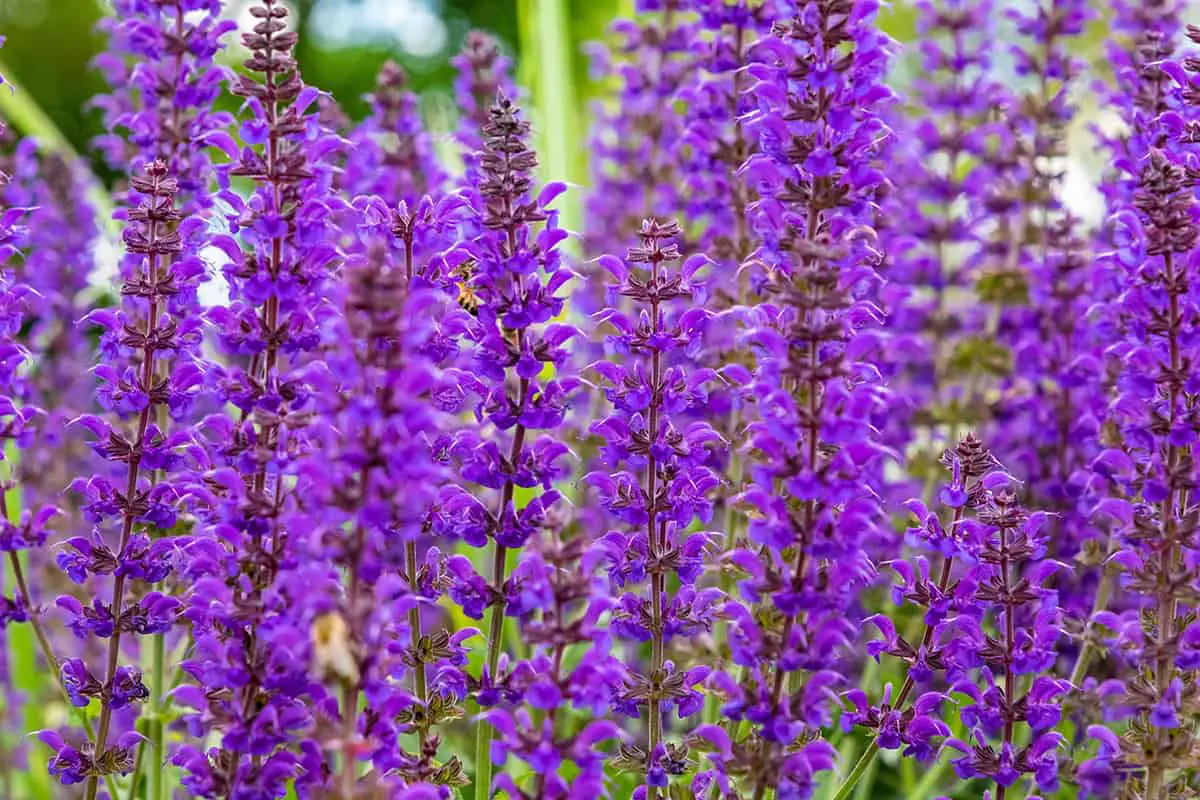
- Botanical name: Salvia officinalis ‘Purpurascens’
- Family: Lamiaceae
- USDA hardiness zones: 6- 9
- Mature height: 1 to 2 feet
- Mature spread: 1 to 2 feet
Purple Sage is a variety of Common Garden Sage. It is a dwarf shrub and is semi-evergreen with a tight, compact growth habit. It continually produces new leaves, which are a purple-silver color, and these will gradually develop into gray-green.
The plant has a two-toned effect, with new purple leaves mixed amongst the older, more green-hued leaves. It is incredibly ornamental and has an attractive scent associated with sage. It is also edible and can be used to add extra color to dishes that contain sage as an ingredient.
This is an award-winning plant, which works well in containers, borders, or even a low informal hedge. Trimming back the leaves in spring will help to promote new growth so that you can enjoy more purple foliage. Purple Sage grows best in full sun, but it can tolerate some partial shade. It prefers average to fertile soils, which are dry or have moderate levels of moisture.
Weigela ‘Foliis Purpureis’
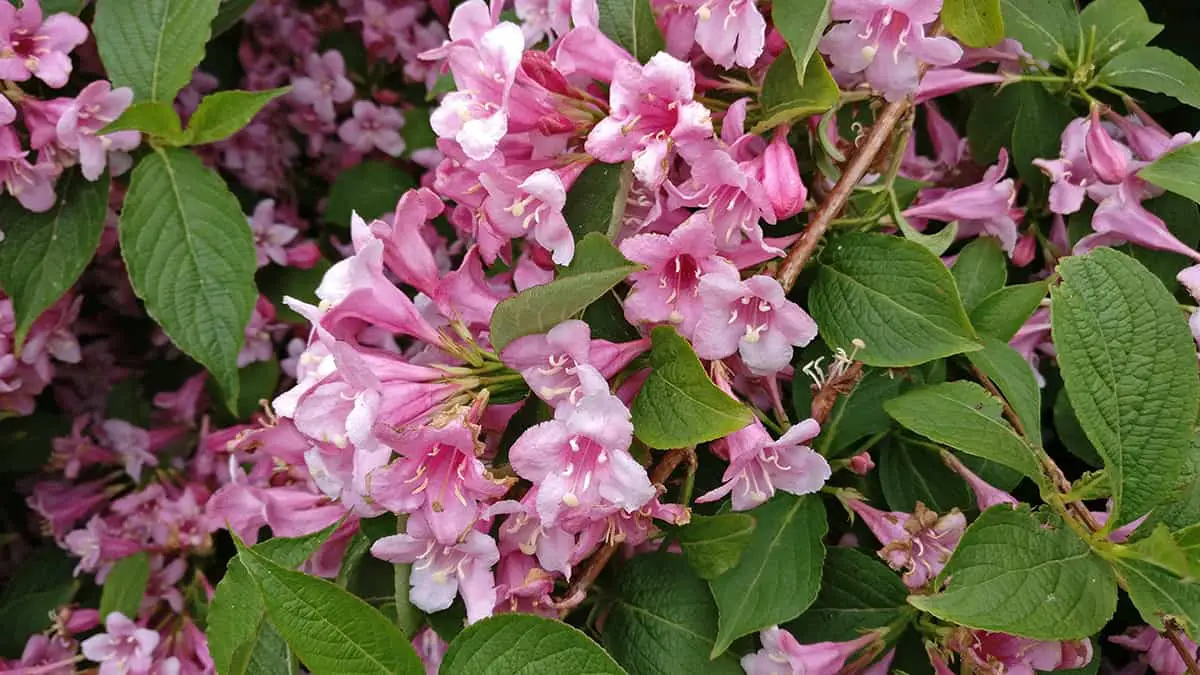
- Botanical name: Weigela florida ‘Foliis Purpureis’
- Family: Caprifoliaceae
- USDA hardiness zones: 4- 8
- Mature height: Up to 3 feet
- Mature spread: Up to 3 feet
This is a compact, deciduous shrub and is a dwarf variety of the Weigela florida. The foliage of this plant is a burgundy shade, with tones of purple, red, and dark green, appearing at different times of the year. Unlike most other types of Weigela, which produce white flowers, this variety produces vivid hot pink blooms in a funnel shape.
The insides of the flowers are a paler shade of pink, creating a two-tone effect. This is a slow-growing plant, taking between 10 and 20 years to reach its mature height of around 3 feet. It will bloom in spring and summer, with flowers being more abundant when the plant receives a greater proportion of light.
The Weigela ‘Foliis Purpureis’ can grow in full sun, partial sun, and even in full shade, making it a great choice for gardens with shaded areas; however, you can expect fewer flowers and more dull foliage color in this instance. The plant will adapt to a wide range of soil but prefers those which are kept consistently moist.
Smokebush ‘Royal Purple’
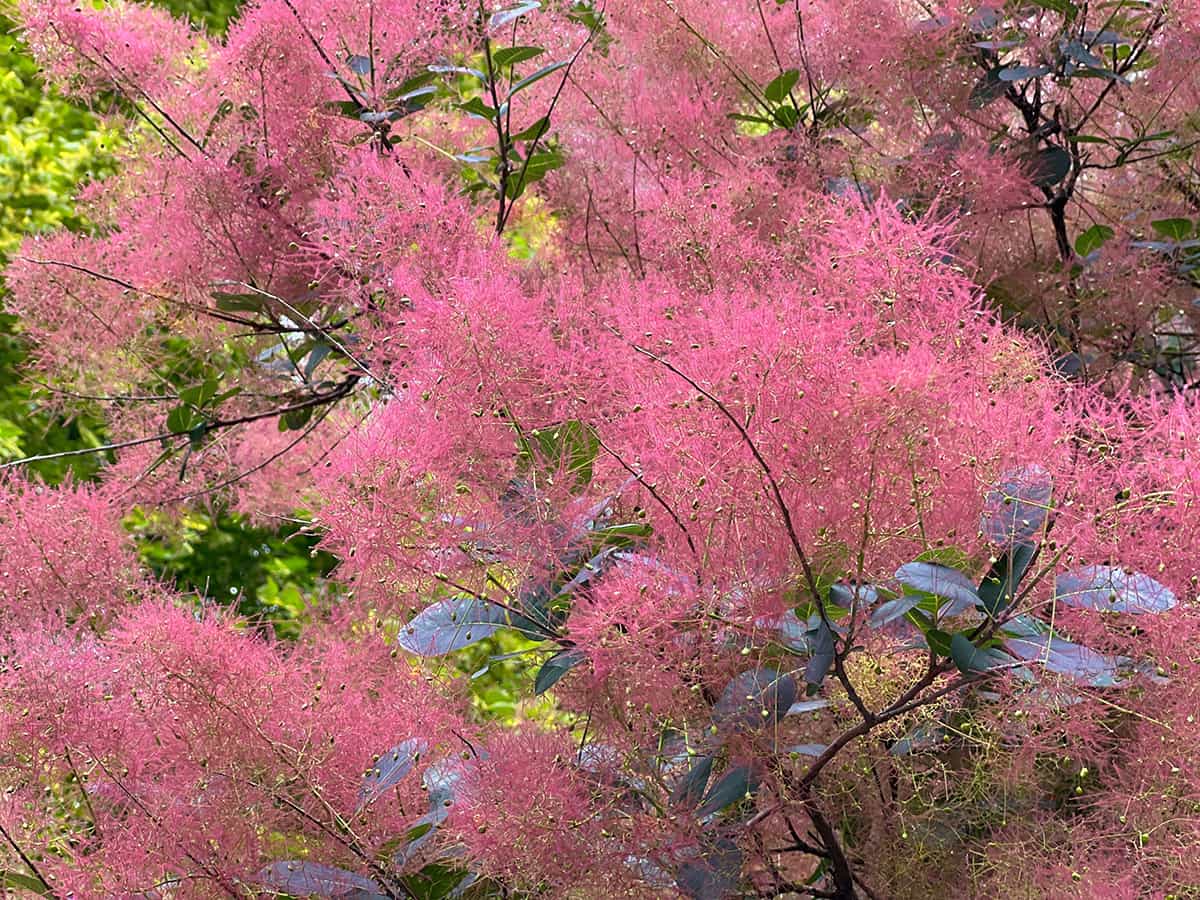
- Botanical name: Cotinus coggygria ‘Royal Purple’
- Family: Anacardiaceae
- USDA hardiness zones: 4- 9
- Mature height: 10 to 15 feet
- Mature spread: 15 to 20 feet
This is an award-winning deciduous shrub that grows to up to 15 feet in height, with an even larger spread of up to 20 feet. The plant is known for its strikingly colorful foliage, which is a deep shade of red when it first emerges on the bare branches in spring and then develops to a rich shade of violet-purple in the summer.
By fall, the leaves will have once again reverted to a burgundy-red color. From late spring and throughout summer, flowers are produced, which the plant is named after. These blooms are fluffy and gray-pink in color, creating the look of clouds of smoke covering the shrub, hence the name ‘Smokebush’.
This plant is hugely popular with butterflies, attracting a mass of pollinators to the garden. It grows best in full sun or partial shade, but for the most intense foliage color, the plant should be positioned in full sun. Smokebush is able to adapt to a wide range of soil types as long as they are well-draining since it cannot tolerate wet or waterlogged soils.
Holly Olive ‘Purpureus’
- Botanical name: Osmanthus heterophyllus ‘Purpureus’
- Family: Oleaceae
- USDA hardiness zones: 7- 9
- Mature height: Up to 10 feet
- Mature spread: Up to 8 feet
This evergreen shrub is also known as False Holly and Chinese Holly. It is commonly mistaken for a Holly bush since the shape of its foliage closely resembles English Holly (Ilex aquifolium), however, it is not related to Holly and instead belongs to the Olive family (Oleaceae). The ‘Purpureus’ variety of this plant produces new foliage, which is thick, spiny, and leathery in texture and a deep shade of purple when young that looks black in some light.
As the leaves mature, they will develop into a fresh shade of green. The plant flowers heavily in late summer and fall, adding interest late into the season. The flowers are white and tiny, pleasantly scented, and arrive in dense clusters. After blooming, the flowers will give way to berry-like fruit in deep blue or black. Grow Holly Olive in full sun or partial shade in well-draining soil.
Kohuhu
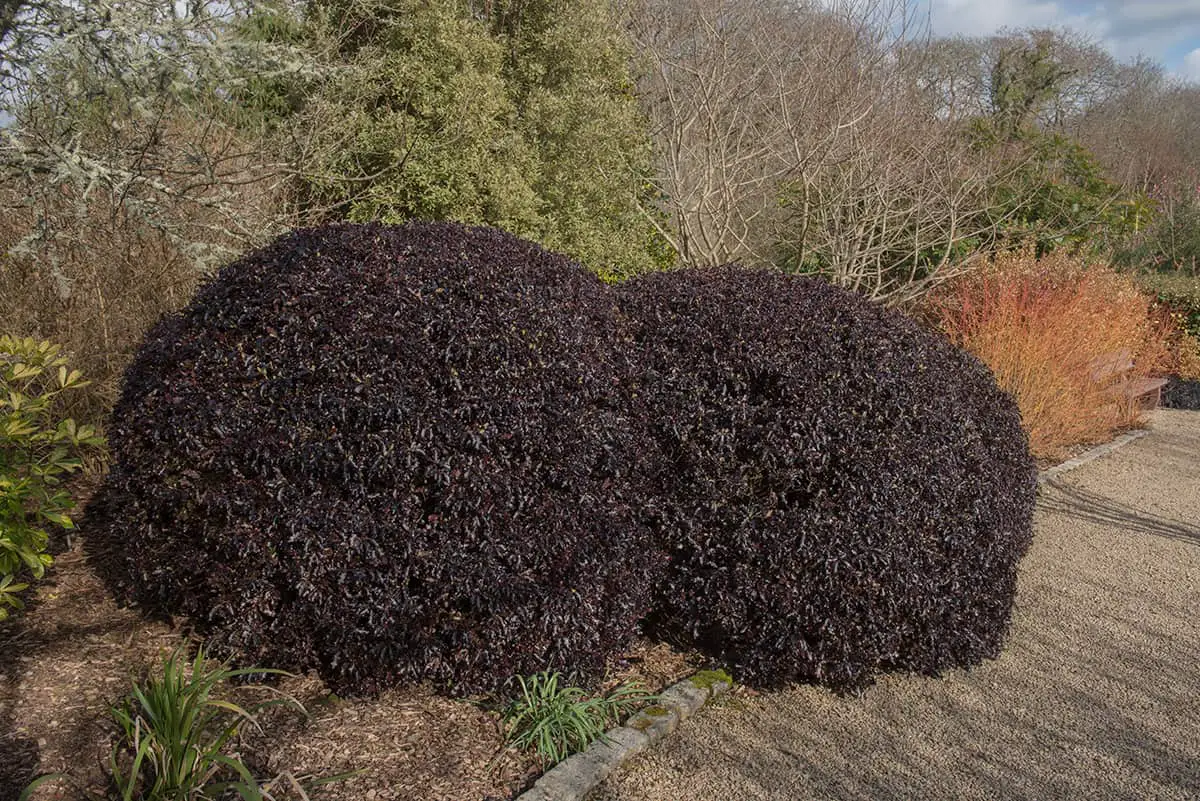
- Botanical name: Pittosporum tenuifolium
- Family: Pittosporaceae
- USDA hardiness zones: 9- 10
- Mature height: Up to 10 feet
- Mature spread: Up to 10 feet
The Kohuhu plant is native to New Zealand, and is an evergreen shrub that can produce brightly colored variegated foliage. The leaves of the plant are generally quite small, measuring in at between 2 and 3 inches in length, with a glossy texture. There are several varieties of Kohuhu which produce purple foliage.
Kohuhu ‘Purpureum‘ is actually named after the dark purple flowers it produces, but its leaves are also purple in color. They emerge a pale shade of green before gradually developing to a dark eggplant color. The result is a two-toned plant when there is mature growth as well as a new growth on the shrub.
The Kohuhu ‘Elizabeth’ is an exceptionally beautiful shrub that has mottle, pale blue-gray leaves, which are crinkled at the edges. The outer edge of each leaf is bordered in bright violet, making each leaf look as though it has been framed. The Kohuhu ‘Tom Thumb’ is another purple foliage variety.
Its leaves start out green but soon develop to a rich shade of purple, making for a striking contrast between old and new growth. The flowers of this plant are so small that they are easy to miss. Interestingly, the blooms have a sweet scent which they only give off at night. The Kohuhu plant comes in small varieties, which max out at around 3 feet in height, or larger varieties growing up to 10 feet tall. They should be grown in full sun or partial shade and prefer rich soil which is kept moist.
Houmspara ‘Purpureus’
- Botanical name: Pseudopanax lessonii ‘Purpureus’
- Family: Araliaceae
- USDA hardiness zones: 9
- Mature height: Up to 8 feet
- Mature spread: Up to 8 feet
This plant goes by a number of common names, including Houmspara, Houpara, and Houspara. It is an evergreen plant, is native to New Zealand, and can be grown as a shrub or a small tree. The ‘Purpureus’ variety has an upright habit and is multi-stemmed. It sends out heavily lobed foliage, which is a golden purple color and has a leathery texture.
This is a very exotic looking plant that can work well in tropical-style gardens for dramatic effect. It produces small green flowers, but these are generally considered inconsequential compared with stunning foliage. The plant is relatively fast-growing, taking as little as five years to reach its mature size. It thrives in full sun but can also tolerate a little shade. Grow it in loamy soil, which is well-draining.
Elderberry ‘Guincho Purple’
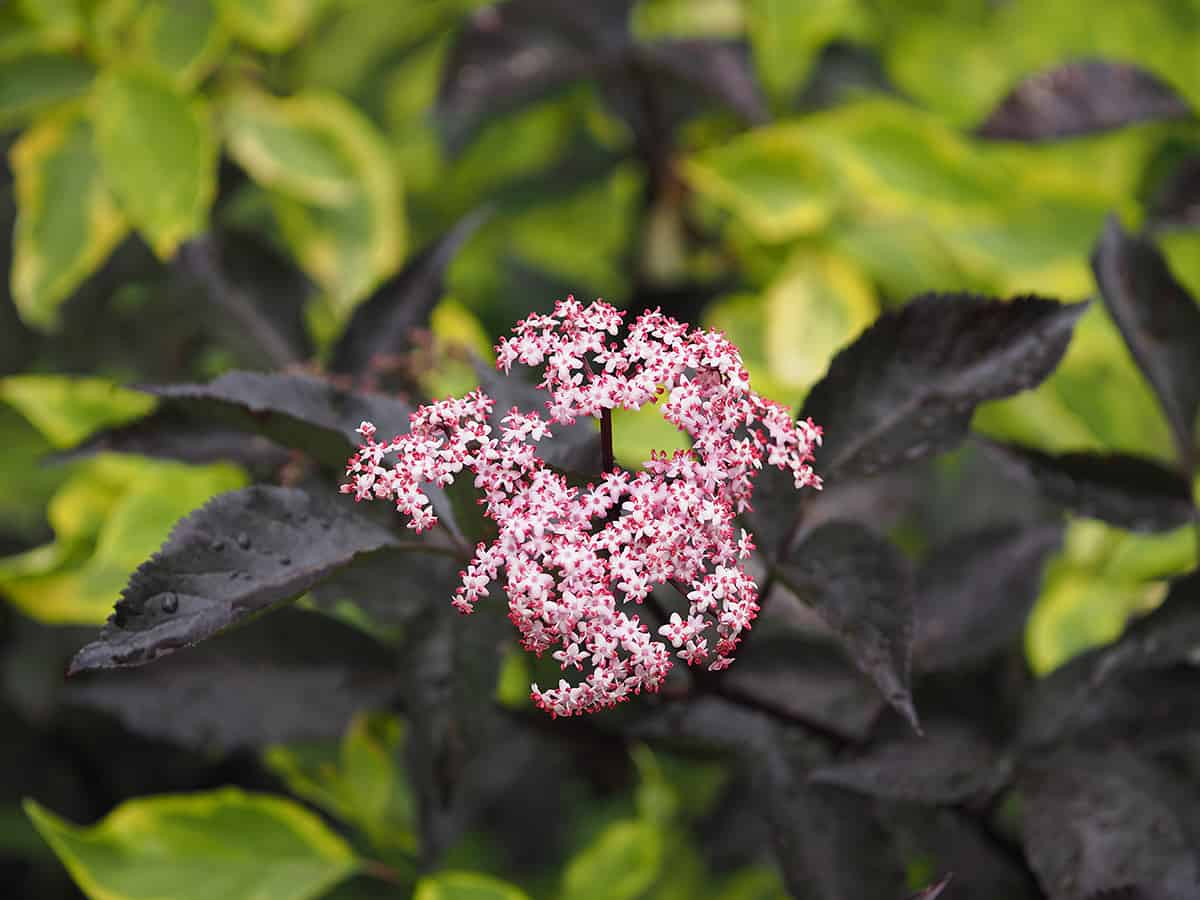
- Botanical name: Sambucus nigra f. porphyrophylla ‘Guincho Purple’
- Family: Adoxaceae
- USDA hardiness zones: 4- 7
- Mature height: Up to 30 feet
- Mature spread: Up to 20 feet
Elderberry can be grown as a shrub or tree and is widely grown for its ornamental value as well as for the flowers and berries it produces, which are used in the making of beverages such as wine and cordial. Elderberry is deciduous and produces heavy panicles of creamy-colored flowers, which will develop into clusters of berries in white, red, or black.
The berries are edible when cooked, and the flowers are also safe for consumption. However, the remainder of the plant should not be eaten since it will have unpleasant side effects. The ‘Guincho Purple’ variety of Elderberry has leaves that are green when they first emerge, and these transform into a vivid shade of purple during summer before progressing to purple-red in the fall and dropping from the tree.
The flowers of this variety are pink and are followed by black berries. This is an exceptionally attractive specimen plant, which is hardy down to USDA zone 4. It thrives in full sun and partial shade and can adapt to various types of soil as long as they are well draining.
Barberry ‘Superba’
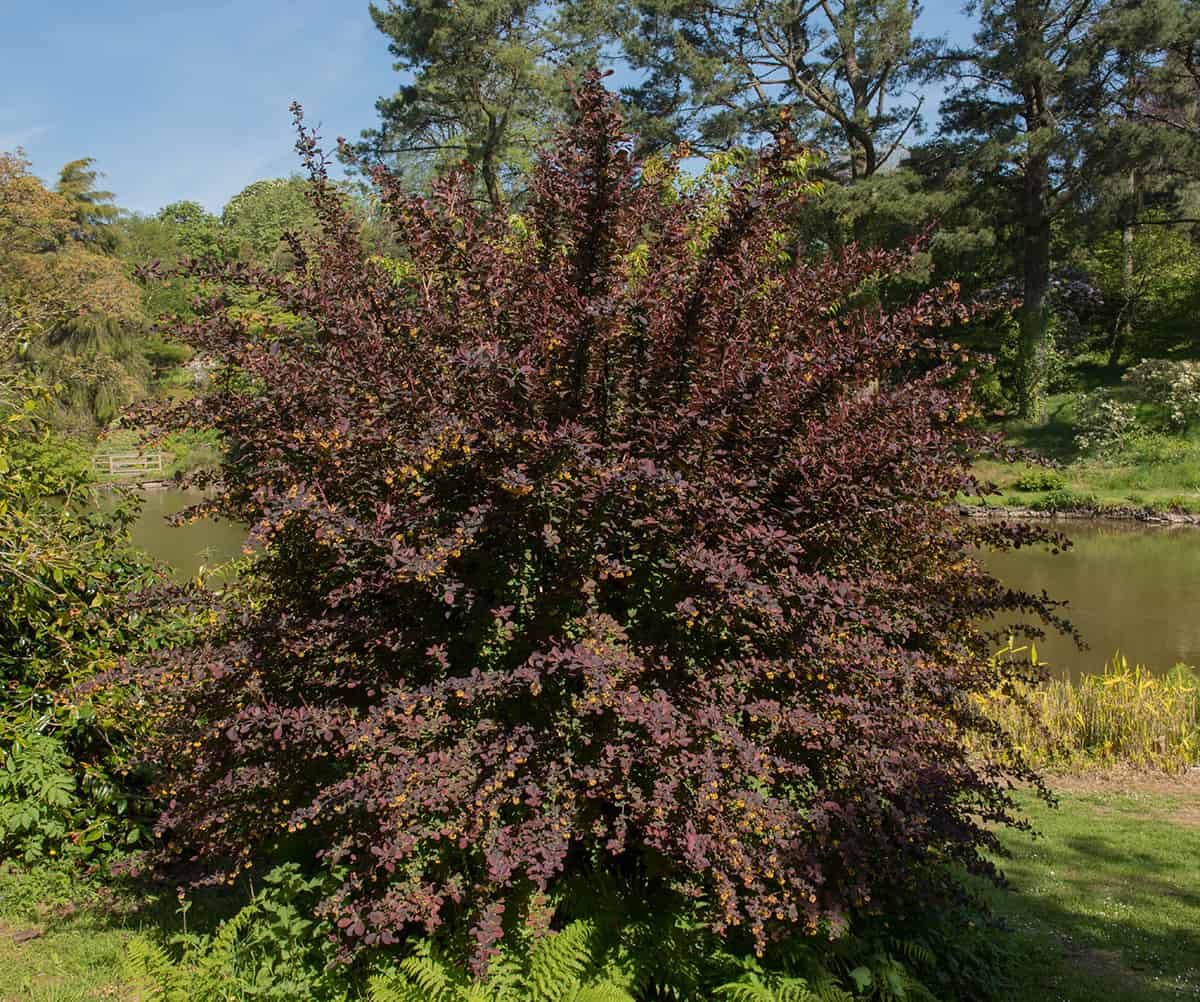
- Botanical name: Berberis × ottawensis f. purpurea ‘Superba’
- Family: Berberidaceae
- USDA hardiness zones: 5- 8
- Mature height: Up to 6 feet
- Mature spread: Up to 6 feet
This is a hybrid variety of Barberry, which takes the shape of a deciduous shrub. It is known for its striking purple foliage, which starts out red in spring before developing to purple in the summer and then taking on an intense shade of purple-red in the fall. Unusually for a plant with colored foliage, the most vivid coloring on the leaves appears in fall rather than summer, although each season of this shrub is attractive in a different way.
The plant also produces yellow flowers, which provide an extreme contrast against the purple foliage. These are followed by berries which are red. This plant will perform best in full sun or partial shade, and it is tolerant of a wide range of soils, though it prefers well-draining soils.
